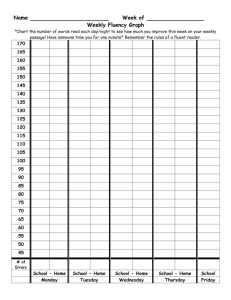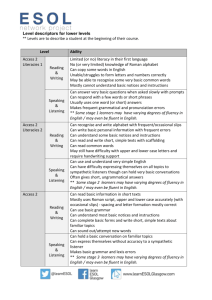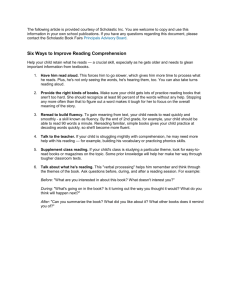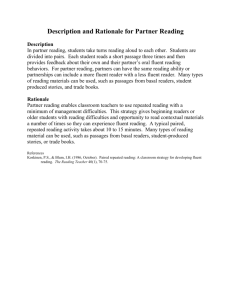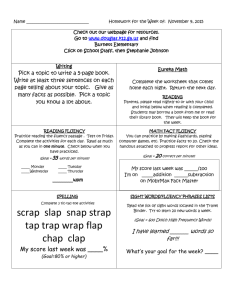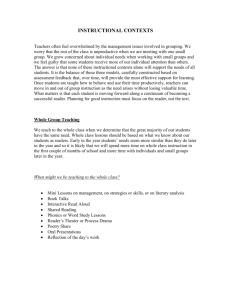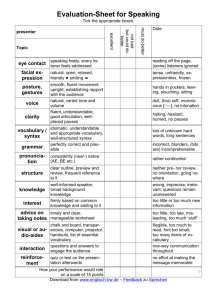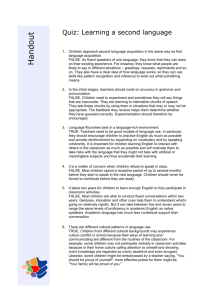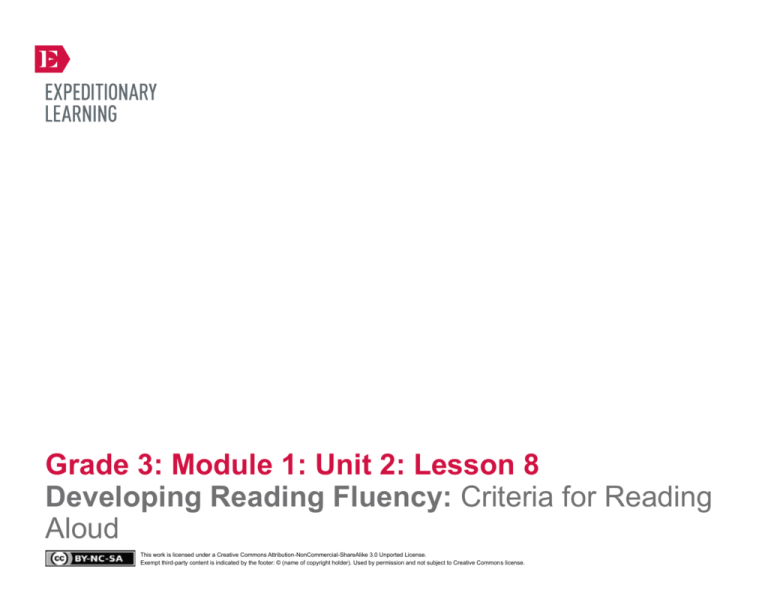
Grade 3: Module 1: Unit 2: Lesson 8
Developing Reading Fluency: Criteria for Reading
Aloud
This work is licensed under a Creative Commons Attribution-NonCommercial-ShareAlike 3.0 Unported License.
Exempt third-party content is indicated by the footer: © (name of copyright holder). Used by permission and not subject to Creative Commons license.
GRADE 3: MODULE 1: UNIT 2: LESSON 8
Developing Reading Fluency:
Criteria for Reading Aloud
Long-Term Targets Addressed (Based on NYSP12 ELA CCLS)
I can demonstrate fluency when reading stories or poems for an audio recording. (SL.3.5)
Supporting Learning Targets
Ongoing Assessment
• I can identify the skills of a fluent reader.
• Student Criteria recording form
• I can practice reading an excerpt from my independent reading book with fluency.
• Fluent Reading Criteria checklist (completed after listening
to individual students read)
Agenda
Teaching Notes
1. Opening
• This lesson formally introduces the term fluency as a reading superpower; students, of course, have
been building fluency throughout the module, so they may already know this term.
A. Engaging the Reader : Audio Recording or Readaloud (10 minutes)
B. Generate Criteria for a Fluent Read-aloud
(10 minutes)
• For Work Time, Part A, an excerpt from Thank You, Mr. Falker may be a good option as a text to use
here, since it is relevant in content (reading superpowers, specifically Trisha’s fluency) and is short and
familiar (from Lessons 1 and 2). This text also gives students a chance to attend to dialogue and
punctuation as fluent readers. Remember that students will need their eyes on a copy of the text as you
read. Note that this text is above the third-grade Lexile1 range; use professional judgment and choose
another text if necessary or appropriate.
C. Whole Group Practice and Check-in against Criteria
(10 minutes)
• For Work Time, Part A: Choose an excerpt from the text Thank You, Mr. Falker that includes examples
of dialogue and varied punctuation.
D. Partner Practice with Check-in against Criteria (10
minutes)
• For Work Time, Part D: Choose excerpts from a familiar class text (book or poem) at an appropriate
Lexile range for students to practice fluent reading. Another option is to have students choose excerpts
from their own independent reading books (as long as the texts are at an appropriate Lexile range). A
Fluent Reading Criteria checklist is provided for you to use or share with students. Adapt as needed.
2. Work Time
A. Whole Group Listen to Read-aloud (15 minutes)
3. Closing and Assessment
A. Debrief (5 minutes)
4. Homework
• Some vocabulary words may need to be clarified with students: story teller, power
A. Practice reading a book or book excerpt aloud to
someone.
Lexile® is a trademark of MetaMetrics, Inc., and registered in the United States and abroad.
Copyright © 2012 MetaMetrics, Inc. All rights reserved.
Copyright © 2013 by Expeditionary Learning, New York, NY. All Rights Reserved.
NYS Common Core ELA Curriculum • G3:M1:U2:L8 • March 2014 •
1
GRADE 3: MODULE 1: UNIT 2: LESSON 8
Developing Reading Fluency:
Criteria for Reading Aloud
Lesson Vocabulary
Materials
identify, skills, practice, excerpt, readaloud, fluent, fluency, phrasing, rate,
expression, punctuation, criteria
• A short poem of the teacher’s choice: audio recording and/or one copy per student
• One or two excerpts from the text Thank You, Mr. Falker (refer to supporting materials for Lesson 1)
• Chart paper for new Fluency Criteria anchor chart (teacher-created)
• Identifying Criteria for a Fluent Reader (one per student)
• Fluent Reading Criteria Checklist
• Markers
• An excerpt from students’ individual independent reading books or a common class text (at an appropriate Lexile range)
Opening
Meeting Students’ Needs
A. Engaging the Reader : Audio Recording or Read-aloud (10 minutes)
• Play an audio recording (or do a choral reading) of a short poem. (Options might include a poem from I Am the Book,
compiled by Lee Bennett Hopkins, or use any poem with which students are familiar.) Invite students to clap and/or chant
along as appropriate.
• Consider posting nonlinguistic
symbols (e.g., two people talking for
discuss, a pen for record, a
magnifying glass for details, a
lightbulb for main idea) to assist
ELLs in making connections with
vocabulary. These symbols can be
used throughout the year.
• Share the first learning target: “I can identify the skills of a fluent reader.” Circle the words identify, skills, and fluent. Invite
students to share out the meaning of identify (this is a familiar word from previous targets—anticipate definitions such as
“name,” “see,” or “discover.”) Discuss the word fluent on a basic level: “It’s how we want our reading to sound when we read
it aloud.” Tell them: “We will talk about the characteristics of a fluent reader later in the lesson.” Repeat with the second
target: “I can practice reading an excerpt from my independent reading book with fluency,” attending to the words practice,
excerpt, and fluency.
• Ask: “Why might practicing reading aloud to others be a way for each of us to build reading power?” Students may share
their ideas first with a partner using a Think-Pair-Share and then with the whole class.
Copyright © 2013 by Expeditionary Learning, New York, NY. All Rights Reserved.
• Check for comprehension of the
question with ELLs, who may need
clarification on words such as might
or expressions such as build
reading power.
NYS Common Core ELA Curriculum • G3:M1:U2:L8 • March 2014 •
2
GRADE 3: MODULE 1: UNIT 2: LESSON 8
Developing Reading Fluency:
Criteria for Reading Aloud
Work Time
Meeting Students’ Needs
A. Whole Group Listen to Read-aloud (15 minutes)
• Invite students into this fluency study: “We have discovered that one way readers build their reading power is by reading
aloud to yourself and others. You have been practicing this as homework with some of the stories we have read. In a few
days, each of you will read aloud a short text to demonstrate your reading superpowers. It is important that our reading is
fluent so that the audience can understand the meaning. Fluency is another skill we will add to our reading powers. This will
be fun and important work for us as readers.”
• Remind them that they have been building their fluency in several ways in this module: by reading along during teacher
read-alouds, by rereading, and by reading aloud to others or themselves (for homework).
• Say: “As you are listening, please pay careful attention to what makes a fluent reader good. I am going to ask you at the end
of the reading to identify what a fluent reader sounds like.” Check for student understanding of the task at hand.
• Read the text excerpt aloud. Pause to re-engage students with their purpose. Then ask: “What does a fluent reader sound
like?” Students either may write down what they hear or simply listen.
• Audio recordings of text can aid
ELLs in comprehension. Consider
allowing ELLs exposure to the
recording prior to instruction.
B. Generate Criteria for a Fluent Read-aloud (10 minutes)
• In the Pair-Share, a sentence starter
may assist ELLs in participating in
the discussion.
• Distribute the Identifying Criteria for Fluent Reading handout to students.
• Ask students to Pair-Share two ideas about what makes a fluent reader good. Listen in to identify students who use words
that you want to include on a new Fluency Criteria anchor chart.
• Guide students toward the characteristics of a fluent reader that will become your criteria list, and use picture clues or word
clues to define any new vocabulary.
• Suggested attributes are:
• Check for comprehension with ELLs
of words that most students would
know (i.e., fluent, text). Have
students document words in
vocabulary logs or personal
dictionaries, or keep the cards
where they log vocabulary words on
a ring.
• Consider using nonlinguistic
symbols throughout the module to
represent: fluency, phrasing, rate,
punctuation, and expression.
* Phrasing
* Rate
* Punctuation
* Expression
• Include the words that students might use to describe these words alongside the fluency vocabulary word (e.g., next to the
word rate one might write “not too fast and not too slow”).
• Students may create vocabulary cards with fluency terms.
Copyright © 2013 by Expeditionary Learning, New York, NY. All Rights Reserved.
NYS Common Core ELA Curriculum • G3:M1:U2:L8 • March 2014 •
3
GRADE 3: MODULE 1: UNIT 2: LESSON 8
Developing Reading Fluency:
Criteria for Reading Aloud
Meeting Students’ Needs
Work Time
C. Whole Group Practice and Check-in against Criteria (10 minutes)
• Display another excerpt from Thank You, Mr. Falker, so all students can see it. Invite students to turn and talk about what
they remember about the story. What was the main message or lesson? What did Trisha “want” and how did she overcome
her challenges? Listen for students to comment on how Trisha worked hard to read.
• Point out to students that Trisha had to learn several skills before she was really a reader. One was just to learn how to make
sense of the words on the page (decoding). Another skill was the ability to read out loud so the words flowed. That’s fluency:
what students will be practicing today.
• Focus on examples of dialogue and varied punctuation. Read the passage aloud once to the class. Point out the words in the
text as students listen in. Invite them to notice how conventions of writing (e.g., quotation marks, exclamation points,
question marks) are fluency clues for readers.
• As a whole class, reread the text as a choral read.
• Ask students to think about how well the class did with the choral read. Identify a star (area of strength) and step (area of
growth) as a whole group based on the criteria. Use sentence frames to support feedback such as: “I like how we _______,”
and “I think we would be more fluent if we _______.”
D. Partner Practice with Check-in against Criteria (10 minutes)
• If you choose, share with students the Fluent Reading Criteria Checklist (or something similar you have created or
adapted).
• Ask students to meet with a partner to practice reading fluently. They may choose to read either an excerpt from their
individual independent reading books or an excerpt from a familiar whole class text. Encourage students to
read the text together first and then take turns reading to one another.
• After their practice, ask students to give verbal feedback to their partners using the star and step framework. Again, consider
using similar sentence frames: “I like how you_______,” and “I think you would be more fluent if you_______.”
• Consider partnering ELLs with
students who can model English
pronunciation. The practice of
reading aloud with feedback from a
partner whose L1 is English will
assist students with language
acquisition.
Note: Any text chosen for the partner practice should be at an appropriate Lexile range for each child.
Copyright © 2013 by Expeditionary Learning, New York, NY. All Rights Reserved.
NYS Common Core ELA Curriculum • G3:M1:U2:L8 • March 2014 •
4
GRADE 3: MODULE 1: UNIT 2: LESSON 8
Developing Reading Fluency:
Criteria for Reading Aloud
Closing and Assessment
Meeting Students’ Needs
A. Debrief (5 minutes)
• Invite students to silently reflect on how it went to read as partners. What is one star (area of strength) you showed as a
fluent reader? What is one step (area of growth) to improve your fluency? Students Pair-Share their reflection using
sentence frames: “I like how I _____” and “I would be more fluent as a reader if I _______.” Students can add their fluent
reader goal to their other reading power goals.
• Some students, including ELLs, may
not understand the expressions
“area of strength” or “area of
growth” the first time. Use visuals to
represent the star and step next to
the sentence frame.
Homework
Meeting Students’ Needs
• Practice reading a book or book excerpt aloud to someone. First read it five to eight times to yourself, focusing on fluency.
Then share it with a listener. The listener can then give you a star and a step on the fluency feedback form.
Note: For the opening of Lesson 9, choose a short poem about the power of reading. Consider using one of the poems from the
book I Am the Book by Lee Bennett Hopkins (see Unit 1 Recommended Texts) or another favorite poem of your choice.
Copyright © 2013 by Expeditionary Learning, New York, NY. All Rights Reserved.
NYS Common Core ELA Curriculum • G3:M1:U2:L8 • March 2014 •
5
Grade 3: Module 1: Unit 2: Lesson 8
Supporting Materials
This work is licensed under a Creative Commons Attribution-NonCommercial-ShareAlike 3.0 Unported License.
Exempt third-party content is indicated by the footer: © (name of copyright holder). Used by permission and not subject to Creative Commons license.
GRADE 3: MODULE 1: UNIT 2: LESSON 8
Identifying Criteria for a Fluent Reader
What does a fluent reader sound like?
1.
2.
3.
4.
Copyright © 2013 by Expeditionary Learning, New York, NY. All Rights Reserved.
NYS Common Core ELA Curriculum • G3:M1:U2:L8 • March 2014 •
7
GRADE 3: MODULE 1: UNIT 2: LESSON 8
Developing Reading Fluency:
Selecting a Text and Practicing Reading Aloud
Target
Not Yet
Almost There
Excellent!
Comments
Phrasing
(I can group
many words
together as I
read.)
Rate
(I can read like I
talk, and I only
stop when it
makes sense in
the text.)
Punctuation
(I can pay
attention to the
punctuation, and
I use it to help me
know how to
read the text.)
Expression
(I can use
expression to
read, and it helps
me understand
the story.)
Copyright © 2013 by Expeditionary Learning, New York, NY. All Rights Reserved.
NYS Common Core ELA Curriculum • G3:M1:U2:L8 • March 2014 •
8

